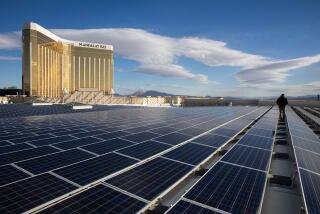Solar Energy Devices Get Back to the Basics : Technology: Motors first used at turn of century are updated to harness sun’s rays. A generator will provide power to Pasadena.
- Share via
A chapter of Pasadena-area history is repeating itself.
The solar motor is coming back a century after it made its original brief appearance in the west San Gabriel Valley.
The setting then was pure California: a roadside attraction in South Pasadena that featured ostriches. Their improbable co-attraction was a “solar engine,” an honest-to-gosh 15-horsepower steam rig powered by the sun, which pumped a thousand gallons a minute to irrigate the ranch that harbored the birds.
The device was invented in 1898 by an Englishman, Aubrey Eneas. He was drawn to the area because a few years previously, a roof-mounted appliance for home water heating had become popular in Pasadena.
“Everybody had one,” said the Pasadena Daily Evening Star in 1899 of the heating units. The solar devices that proliferated in that era looked something like an automobile radiator and heated only about the same amount of water. The rig at the ostrich farm--an “industrial-strength” version--was a one-of-a-kind until this year.
Conner Everts, a city of Pasadena Water and Power Department consultant, said a modern reincarnation of the Eneas solar motor has been built by a friend of his, Tom Miller, on a hillside in Ojai.
Like the original South Pasadena model, Miller’s device in Ojai is evocative of a TV satellite dish. Everts said the sun’s rays are gathered by the shiny Mylar panels of the dish and are focused on a hollow central rod to boil the water as it passes through.
Similarly, in a TV dish--also usually made of plastic--the central rod gathers broadcast signals radiated from a satellite. “Miller’s dish gives you steam. Radio Shack’s gives you sitcoms,” Everts quipped.
Everts’ interest in the Ojai experiment is not just idle curiosity. Soon, the same technology will power a generator known as Solar Two in Barstow that will begin providing Pasadena with electricity by 1995.
The two generators work on the same principles, Everts said.
“But instead of boiling water to power a steam engine or turbine like Tom’s version, the city’s installation in Barstow heats salt to the melting point,” he said. The molten mass of salt fills a storage tank that serves, day and night, to keep water boiling to run a modern turbine generator.
George Morrow, assistant general manager in charge of utility resource planning for the Pasadena Water and Power Department, said the Barstow installation consists of a 300-foot tower surrounded by “heliostats,” a multitude of curved solar collectors somewhat like the Eneas-Miller devices.
Solar Two will provide more than 20 megawatts of electricity, of which Pasadena’s share will be half, or 10,000 kilowatts, enough to power 2,500 homes.
Its cost estimate is $39 million. Miller’s, which powers an engine on one farm, cost $3,500.
More to Read
Inside the business of entertainment
The Wide Shot brings you news, analysis and insights on everything from streaming wars to production — and what it all means for the future.
You may occasionally receive promotional content from the Los Angeles Times.









